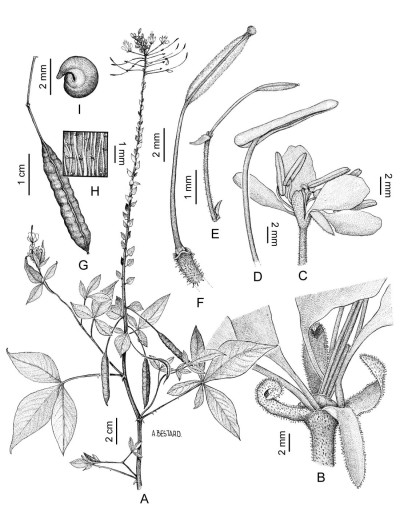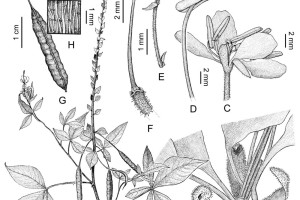Descripcion
Hierbas o arbustos de 1 m de alto; ramas glandular-pubescentes, pubescentes a glabrescentes. Hojas con pecíolos de 3,5-13 cm de largo, pubescentes a glabrescentes, armados con espinas cortas, rectas, delgadas a robustas; espinas estipulares de 2-3 × 1,5 mm, ligeramente curvadas en el ápice; peciólulos de 4-7 mm de largo, armados, pubescentes; láminas 3-7 folioladas, folíolos elípticos a ampliamente elípticos, elípticos-lanceolados, de 5,2-14,5 × 2,3-5,7 cm, basalmente atenuados a cuneados, apicalmente acuminados a largamente acuminados, margen sinuoso-ciliado a serrulado-ciliado, ambas caras glabras o raramente con tricomas eglandulares, cortos, puntiagudos y dispersos, nervadura central y venas secundarias glabras, con espinas. Inflorescencia en racimos corimbiformes, de 30 cm de largo, terminales; brácteas con pecíolos de 2-8 mm de largo, puberulentos y lámina ovada, de 12-30 × 5-17 mm, basalmente redondeada, apicalmente acuminada, margen serrulado-ciliado, glabro. Flores con pedicelos de 10-20 mm de largo, glabrescentes; sépalos linear-triangulares a lanceolados, de 1,5-2 × 0,5-1 mm, agudos a acuminados, margen ciliado, glabrescentes abaxialmente; pétalos oblanceolados, de 3-4 × 1,5 mm, basalmente contraídos en una garra de 0,5-1 mm de largo, apicalmente obtusos, glabrescentes a glabros, blancos a rosado-intenso; nectario disciforme, conspicuamente carnoso, persistente en el fruto; filamentos estaminales de 10-16 mm de largo, morados, anteras de 2-3 mm de largo; ovario cilíndrico, de 3-5 mm de largo, puberulento; estilo de 1 mm de largo, estigma marcadamente capitado, subsésil. Frutos cilíndricos, de 4,7-8 cm × 3-5 mm, ligeramente torulosos, pubescentes a glabros; ginóforo de 0,5-1,5 cm de largo. Semillas suborbiculares, de 1,5 2,2 × 1 mm, aparentemente lisas, longitudinalmente estriadas y finamente estriadas transversalmente, hendiduras cubiertas por una membrana delgada y opaca.
Distribucion y Habitat
Especie muy extendida en el Neotrópico, desde México y América Central (en Costa Rica, Honduras, Nicaragua y Panamá) hasta América del Sur (en la Argentina, Bolivia, Brasil, Colombia, Ecuador, Paraguay, Perú, Surinam y Venezuela). Crece en zonas pantanosas o inundadas y riberas.
Sinónimos
Tarenaya parviflora (Kunth) H.H. Iltis
Bibliografía
Ejemplares de referencia
| Colector | N° Colect. | Especie | Departamento | Provincia | Imagen |
|---|---|---|---|---|---|
|
|
2997 | San Martín | Corrientes |
.thumb.jpg)
|
|
|
|
726 | Santo Tomé | Corrientes |
.thumb.jpg)
|
|
|
|
3352 | - |
.thumb.jpg)
|
||
|
|
29327 | Federación | Entre Ríos |
.thumb.jpg)
|
|
|
|
3209 | Iguazú | Misiones |
.thumb.jpg)
|
|
|
|
14034 | Morretes | Paraná |
.thumb.jpg)
|
|
|
|
-1 | CTES217644 | Paso de los Libres | Corrientes |
.thumb.jpg)
|
|
|
5776 | Alto Paraná |
.thumb.jpg)
|
||
|
|
159 | San Pedro | Misiones |
.thumb.jpg)
|
|
|
|
-1 | 3 | Guaraní | Misiones |
.thumb.jpg)
|
|
|
-1 | 50 | San Ignacio | Misiones |
.thumb.jpg)
|
|
|
23976 | Ituzaingó | Corrientes |
.thumb.jpg)
|
|
|
|
11759 | San Ignacio | Misiones |
.thumb.jpg)
|
|
|
|
16944 | General Alvear | Corrientes |
.thumb.jpg)
|
|
|
|
19949 | Santo Tomé | Corrientes |
.thumb.jpg)
|
|
|
|
7090 | San Javier | Misiones |
.thumb.jpg)
|
|
|
|
11104 | Guairá |
.thumb.jpg)
|
||
|
|
2146 | Iguazú | Misiones |
.thumb.jpg)
|
|
|
|
8140 | Cainguás | Misiones |
Nombre Vulgar y Usos
Tipo y Observaciones
Material Tipo: Basónimo: Cleome parviflora Kunth
Observaciones:

.mid.jpg)
_F ARG.mid.jpg)

_F ARG.thumb.jpg)
